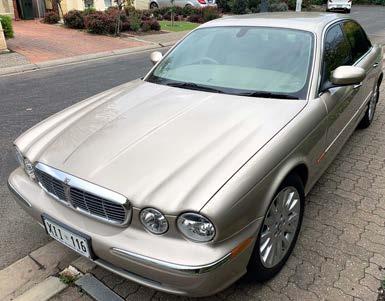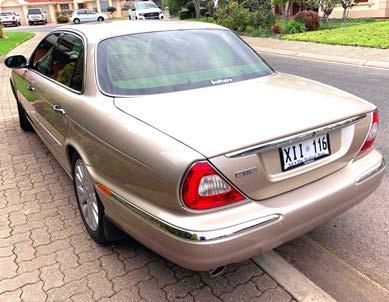
15 minute read
Feature Jaguar XJ X350/X358
It’s the first time a luxury saloon has ever been built with a monocoque structure made entirely from aluminium and rivet-bonding technology found in the latest aerospace construction technologies.
This makes for an XJ that is lightweight yet enormously strong. Fuel efficient yet dynamic. The all-new XJ. It’s an entirely different animal.
The all-aluminium X350 was a radical departure for Jaguar, even if it didn’t look it.
In 2003, Jaguar introduced the reengineered and newly designed third generation of the XJ, continuing with the XJ8 model designation. Designated internally as the X350, it had an all-aluminium body and chassis, a new V8 engine, as well as greater interior and luggage spaces. It was the first Jaguar XJ to be completely designed under Ford ownership. The X350 was noted for its advanced electrical systems, self-levelling adaptive air suspension and full aluminium unibody chassis and bodywork, among the first for a mass-produced automobile.
Design
Overtime each generation of XJ became progressively larger: ◊ Wheelbase: XJ Series1/2/3 2,762mm and 2,864mm (LWB) ◊ Wheelbase: XJ40/X300/X308 2,870mm and 2,997mm (LWB) ◊ Wheelbase: X350/X358 3,033 mm and 3,160 mm (LWB) In the end the X350 was longer than a Mark X/420G (3,048mm) and was wider, longer and higher than its predecessor with increased head, leg, and shoulder room. In order to prevent the weight of the X350 mushrooming, the decision was taken to create the body in aluminium using radical lightweight technology under its retro looks. At the time, this was a revolutionary step, with only Audi having successfully produced a large monocoque saloon car in aluminium. Ford provided the required resources and developed a construction process which is still used by Jaguar today. Unlike the extruded aluminium spaceframes used by Audi, Jaguar’s aluminium bodies employed bonded and riveted construction, with the hightech aerospace-grade epoxy adhesives that were fully cured by the heat of the paint oven. It was clever stuff with testing showing that the aluminium itself would fail before the adhesive let go. Despite this, there were still constraints imposed by aluminium’s relative lack of strength compared to a conventional steel body, and this heavily influenced the style of the new car. With the need to retain torsional stiffness the pillars became wider and the waist line raised. The rising feature line in the lower half of the rear doors was incorporated to help visually slim the sides of the car. To reduce front-end collision repair costs associated with aluminium construction, the body was designed to withstand an impact of 10 mph without structural damage and used a bolt-on front-end module. A hydroformed aluminium extrusion with an energy absorbing foam cover formed a bumper beam cross-member, to provide strength and crushability in the event of a minor collision. Sacrificial extruded aluminium “crash cans” were designed to protect the body structure and front-end componentry. Following extensive customer research, the X350 employed a familiar Jaguar face, with the sculpted four-lamp front end and slated grille, familiar from the earliest XJ. In the end the appearance of the car really didn’t matter a great deal, since road testers and customers alike were impressed by Jaguar’s newfound standards of quality, refinement and pace.

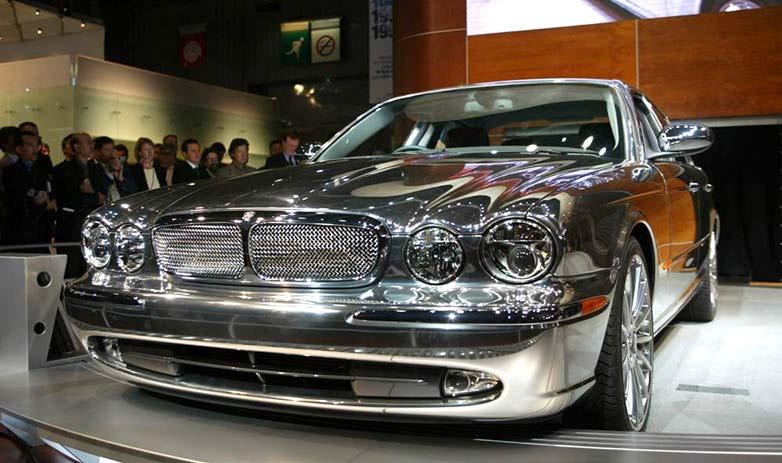
When the XJ X350 saloon made its debut at the 2002 Paris Motor Show, Jaguar was keen to show off its high-tech manufacturing process. To do so, the car made its debut completely ‘naked’. This car is an early pre-production X350 (V8 engine), which was specially finished in polished aluminium to show off the new body material. Together with a similarly-finished left-hand drive car, it was used for the launch presentation and motor show displays, before it was presented to the JDHT for preservation.
Engineering
The X350 employed a multi-link layout with four-wheel self-levelling adaptive air suspension instead of the previous generation’s double wishbone IRS. Suspension was controlled electronically, requiring no intervention from the driver, to adjust damper settings (in milliseconds) and adjust ride and handling under varying conditions. Its electronic control system was marketed as CATS. (Computer Active Technology Suspension). The air suspension was designed to activate every 24 hours to level the vehicle when parked and not in use.
Engines
After dropping the six-cylinder engine for the X308, the X350 re-introduced a range of petrol and diesel V6 engines. The regular XJ8 model now ran the 32-valve 4.2-litre evolution of the AJ-V8 engine, rated at 298 bhp, with the supercharged version in the XJR knocking out a handy 400 bhp. A new 3.5 litre V8 derived from the 4.2 litre engine was also available for some markets. A 3.0 Litre V6 from the S-Type was used for the X350 and was designated as an XJ6. In 2005, Jaguar introduced a dieselpowered XJ TDVi, featuring the same Ford-Peugeot-developed 2.7-litre twinturbocharged V6 found in the S-Type. The engine, known as the AJD-V6 was rated at 201 bhp and was fitted with electronically controlled active engine mounts to minimise vibration at idle.
Transmission
A new six-speed 6HP26 ZF automatic gearbox was fitted to all models. It was lighter than its predecessor and offered better economy with lock-up on all gears and a larger spread of ratios. Although it was claimed that the automatic transmission was sealed for life, independent specialists recommend changing the transmission fluid every 80,000km (50,000 miles) claiming that it can also help cure the slightly jerky takeoff from low speeds.
Safety
Safety systems included four-channel anti-lock brakes with ‘Emergency Brake Assist’; ‘Traction Control’; ‘Dynamic Stability Control’; and front, side thorax as well as full-length side curtain airbags. Electronic coordination of seatbelts and airbags, marketed as ‘Advanced Restraint Technology System’ (ARTS), was designed to sense crash severity, driver position and seatbelt status using ultrasonic and seat weight sensors to optimise airbag deployment force.
Factory Recalls
Overtime a number of Australian recalls have been issued for the X350. These recalls include problems associated with the auto transmission, sunroof glass, diesel engine particulate filter, speed restriction label on the space saver spare wheel and potential corrosion to brake pipes. Jaguar have also issued a number of Technical Bulletins relating to various problems with the automatic transmission including replacement of the Torque Converter in some situations.
Other Technical Bulletins address problems with flat battery’s, constant battery drain, minor electrical problems and brake vibration. For more information goto: Recalls &
Faults Jaguar X350 (2003-09) XJR X350
The 2003 Jaguar XJR was almost anonymous to look at. Other than the ‘XJR’ badge on the boot, different alloy wheels and mesh front grille, this 400hp supercharged saloon could slip past unnoticed. However, it was capable of slipping past other traffic with no trouble at all, although it was electronically restricted to 155mph. All of that subtlety was carried over into the cabin, which was opulently equipped but not garish. In mid-2007, the XJR got deeper front and back bumpers and side skirts.
Long Wheelbase
The long wheelbase model, introduced in 2005, was the longest vehicle Jaguar had manufactured at the time with the rear doors 5 inches longer. The bodyshell’s weight increased by 24 kg and the roof height increased by 7 mm over the standard wheelbase XJ. Turning radius was increased by 330mm over the standard wheelbase model. The rear seating of long wheelbase models could be equipped with either fixed or power-adjustable bench or individually powered and heated seats. The United States was the largest market for the XJ long wheelbase, accounting for more than 80 per cent of LWB’s sold.
Super V8 Portfolio
In early 2005, Jaguar announced the Super V8 Portfolio for the 2006 model year, a limited-edition trim level of the flagship Super V8 saloon. It debuted at the New York International Auto Show in March 2005. The Portfolio trim level included a DVD player and 7-inch screens in the rear headrests. The Super V8 Portfolio was powered by Jaguar’s supercharged 4.2 litre, 32-valve, AJ-V8 engine with a top speed of 249 km/h (155 mph).
Daimler Super Eight/Super V8
The Super V8, also known as the Daimler Super Eight, was the most expensive model, with the XJR being the second most expensive model in the range. The Super V8, which debuted in the 2003 model year in the new X350 body style, was initially of a short-wheelbase configuration. This became an option in 2004 when a long-wheelbase configuration was introduced, along with the supercharged variation of the XJ8 with the more luxurious Vanden Plas, or Daimler interior. A distinctive wire mesh grille and chrome-finished side mirrors set the Super V8 and the XJR apart from the less expensive XJ saloons. In 2005, the Super V8 model was replaced by the Daimler Super Eight in all markets other than North America. The Daimler Super Eight was essentially the same car, but with the addition of a different grille, boxwood inlays finished in wood veneer and several other interior luxuries as standard.
X358 (2007 Facelift)
The facelifted X350 debuted in February 2007 for model year 2008 with a revised front grille and front bumper assembly featuring a prominent lower grille and rear aero spoiler. A Jaguar emblem within the grille replaced the previous bonnet-mounted hood ornament. Front lights were revised and door mirrors incorporated side repeaters. Front fenders/wings had prominent faux side vents, and the side sills, rear bumper and tail lights were revised. The interior featured increased rear leg and foot room thanks to extensively redesigned front seats.
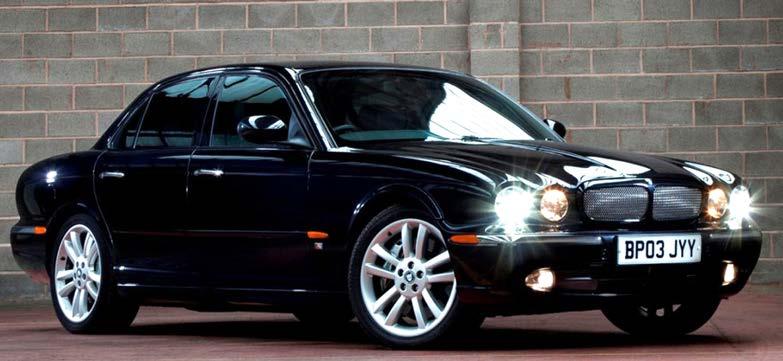
First production X350. This Midnight Black XJR came off the assembly line in December 2002 and was delivered to the collection of the Jaguar Daimler Heritage Trust for preservation. The X350’s were built in Jaguar’s traditional home factory at Browns Lane in Coventry, with bodyshells supplied from Castle Bromwich and engines from Bridgend in Wales. The X350 went on sale in April 2003.
The Jaguar X358 TDVi was featured in an episode of BBC 2’s Top Gear, where it drove from Basel to Blackpool Tower on one tank of fuel. Jeremy Clarkson, who was driving the car at the time, described the car as “astonishing”.
Review
Jaguar historian and author/editor Paul Skilleter test drove an X350 prior to its release in 2003 and supplied ‘Jag-lovers’ with a review of his experiences with the new XJ saloons! Any thoughts that the car’s road behaviour would echo its heavier looks were soon laid to rest. Just as we’ve been led to believe, this new XJ is phenomenally nimble, more so than an S-TYPE - and it makes the old 308 seem like a lumbering dinosaur. Much of the improvement comes from the 60 per cent stiffer shell. The whole car moves as one now, so there is none of that wriggle and twist feeling that occurs when you push the old-style XJ8 hard over indifferent surfaces. The ride qualities are better although the air suspension somehow gives a different feedback. It is not exactly harsher, but there’s a different quality about it. As for handling, with a modern car of this nature the terms oversteer and understeer hardly apply, because unless you’re going at a ridiculous rate for public roads, hardly any slip angles are generated. The new XJ simply feels extremely well-balanced, with the XJR of course having the greater grip courtesy of its wider rubber. Surprise of the bunch for me was the 3.0 litre, as it gave a more than adequate performance, thus breaking the dreary mould set by previous small-engined XJs - be they 2.8, 2.9 or 3.2 (straight six and V8). It has the all-important ‘performance feel’ lacking in these earlier cars, though its progress is hastened by use of the J-gate. The 4.2 really flies and the XJR and Super V8 offer extraordinary levels of acceleration. I wouldn’t want one of those - I’d loose my licence within four days. It goes without saying that refinement is superb throughout the range. There is genuinely much more room in the rear, while the range of adjustment available for the driver is vast - quite apart from the seats and steering, the pedals can be adjusted for reach too, a first for Jaguar. The trunk is huge - though still short of the room available in a Mk X (I measured them both!). If this review for ‘Jag-lovers ‘appears overenthusiastic, I don’t apologise for it. This car is so much better than the old XJ series, and if you don’t want to take my word for it, some of the independent press is rating the new XJ above the Mercedes Benz S-Class in all round competence. As far as I’m concerned, the new car has emulated what the original XJ6 of 1968 achieved. It sets genuine world standards in several key areas. Only now, it won’t fall to bits while doing so.
Successor
The X350/X358 was replaced by the radically different-looking X351 in 2009 that boasted a cutting-edge style similar to the XF but underneath it was the same platform as the X350, showing just how modern the car was despite its retro styling.
Value
Massive depreciation makes Jaguar cars spectacular value right now. The X350 and the X358 facelift are something of a bargain as a modern classic and carry on the XJ’s tradition by offering not only astonishing value but also a driving experience that few others can match, let alone surpass. .
For more information and reviews regarding the X350, consider the following videos.
XJ X350 Promotional Video Top Gear - Jaguar X350 XJR 2003

The final car to leave the Browns Lane assembly line on the 1st of July 2005 was also the X350’s most luxurious and expensive model, the Super V8 Portfolio. Only 300 Portfolio cars were built and were the epitome of both performance and luxury, powered by a 400bhp 4.2-litre V8 and equipped with every conceivable extra. This car was presented to the Jaguar Daimler Heritage Trust for preservation.
DYNAMIC STABILITY CONTROL (DSC)
DSC works with the four-channel anti-lock brake system to help prevent understeer or oversteer by individually monitoring and if necessary, braking each wheel – eliminating uncertainty, without compromising driving pleasure.
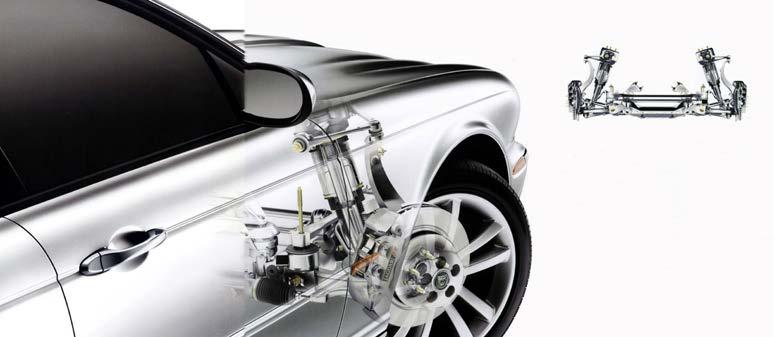
ALUMINIUM INTENSIVE SUSPENSION
To help keep unsprung weight to a minimum, the XJ’s fully independent double wishbone front suspension features strong yet lightweight forged aluminium components.
ADAPTIVE RESTRAINT TECHNOLOGY SYSTEM (A.R.T.S.)
Four ultrasonic sensors plus a weight sensor in the seat, determine the exact position of the front seat passenger. A.R.T.S. uses this information to determine the precise airbag energy levels required for optimum occupant protection.
SIDE IMPACT PROTECTION
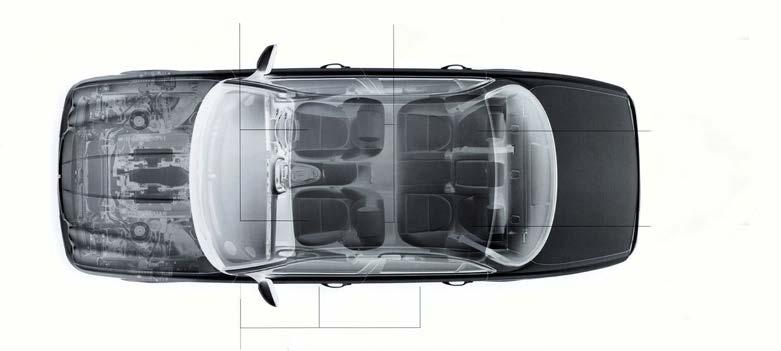
Side curtain airbags located above the front and rear door openings inflate and deploy downwards in a side impact collision, providing vital head protection to the front and rear occupants. At the same time, a thorax airbag inflates from the outer edge of the XJ’s front seats, protecting the side of the occupant’s rib cage.
SIX-SPEED ELECTRONIC AUTOMATIC TRANSMISSION
The electronically controlled transmission is more compact, 12% lighter and has 30% fewer components than the five-speed unit it replaced. The electro-hydraulic control module contributes to smoother shifts and a satisfying, ergonomic feel to the unique J-gate. ENERGY-ABSORBENT BACK RESTRAINT
In a rear impact, one of the biggest sources of injury is whiplash to the neck. The XJ’s active, energy-absorbent front seat back restraints reduce the risk of neck and spinal injury by forcing the seat rearwards, reducing the relative motion of the occupant’s body and head. DRIVE-AWAY LOCKING
For your peace and security, all doors lock automatically when the vehicle travels at speeds above 5mph (18 km/h).
REAR SEAT PASSENGER SAFETY
Rear passengers are protected by electronically activated seatbelt pre-tensioners that react in milliseconds, helping to hold the occupant safely and firmly in position. In a side impact, advanced side curtain airbags above the rear door openings deploy downwards to provide head protection.
EMERGENCY BRAKE ASSIST
If a driver is not applying maximum brake pressure in an emergency situation, Emergency Brake Assist provides additional force to achieve the shortest possible stopping distance.
OIL-COOLED PISTONS
Forged, oil cooled pistons, high density intercoolers and a supercharger that spins 5% faster than before are some of the special features that enable the supercharged 4 2 litre V8 to produce 400 bhp, 33% more peak power than the normally aspirated version.
CONTROLLED POWER The 4.2 litre V8 supercharged delivers more than 80% of its maximum torque from 2,000 rpm, for smooth and instant acceleration from any speed. REFINED V6 The 60 degree 3 0 litre V6 has a lightweight but exceptionally stiff structure - a major contribution to the engine’s impressive refinement. 240 bhp is developed with the aid of four valves per cylinder, a four-mode tuned intake manifold and 32-bit electronic engine management system.
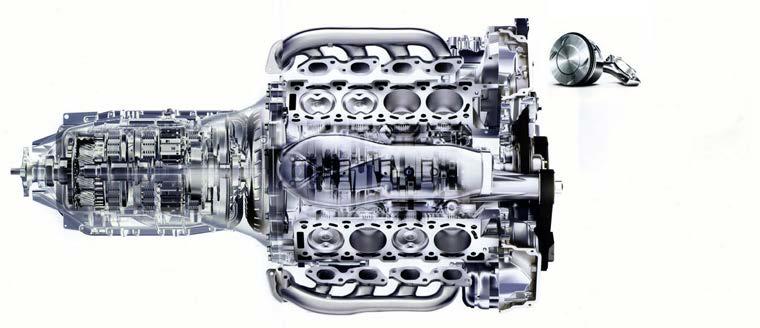
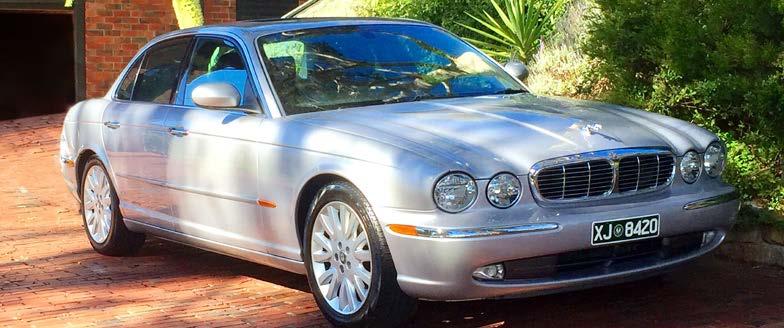
Charles changed the original grille with mesh grilles acquired from Lockwood of Leeds
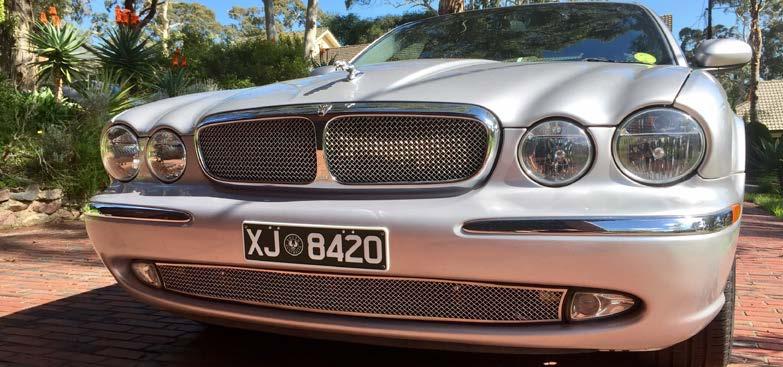
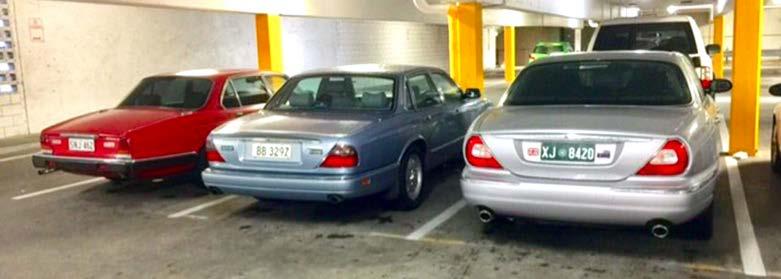
Geoff Clayton, 2006 Topaz Gold XJ8. The car was sold by Solitaire Motors to Past President Dr Peter Clarke in February 2006. Peter sold the car to Geoff & Valerie in August 2012. The car has travelled 71 000 km. (Geoff is a former Classic Marque Editor and Life Member). ‘Editors Note’ - Geoff will be placing this car on the market in the near future and would like it to stay within the club. Contact Geoff on 0410 904 300
